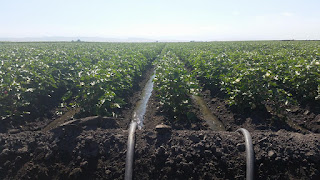Clackety-clack. Clackety-clack. Clackety-clack.
That’s the sound of harvesters crisscrossing acres
and acres of cotton fields around the San Joaquin Valley as twirling spindles
twist the fresh cotton from the burrs attached to the dried plant stems.
Yes,
the cotton harvest has begun after the first seeds were planted some 180 days
ago. Field scout Carlos Silva reports the first sightings of cotton harvesters
this week. Activity will certainly pick up in the coming weeks.
 |
| Harvesters are now starting to pick cotton in the Valley. |
It won’t be long before we’ll see lots of round and
rectangular cotton modules lining the field margins, ready to be hauled off the
nearby gins for processing.
Continued hot weather translates into ideal picking
conditions. There’s no signs of cool damp weather or fog to slow down picking –
that may be one of the positives of the state’s severe drought.
Speaking of the drought, we have to
give credit to those growers who have stuck with cotton as water supplies
became tighter and tighter and more expensive.
 |
| The drought will reduce the amount of cotton harvested. |
Cotton acreage certainly has taken a beating during
these past four rain-starved years. Estimates put this year’s cotton planting
at 162,000 acres (almost a third grown in the San Joaquin Valley), according to
a survey by the California Pink Bollworm Program. That’s the lowest total since
the Great Depression.
Upland
cotton comes in at 46,000 acres while Pima checks in at about 116,000 acres.
Growers are inclined to plant more Pima because the variety commands a greater
price. Most of the nation’s high-quality Pima is grown in California. A number
of long-time growers have told us they have remained dedicated to cotton
because it serves as a good rotational crop.
While the cotton harvest is gearing up, the alfalfa crop is
winding down its harvest season. Carlos reports one grower has finished cutting
his alfalfa and others should start following suit this week. With the arrival
of fall, this could be the final cutting of the year for many growers.
 |
| The alfalfa season is starting to wind down this year. |
Except for a few growers who ended
their alfalfa season early to divert water to other crops, most were able to
continue harvesting throughout the summer. They should end up with the usual 10
or so cuttings for the season. By maintaining production, growers have been
able to keep supplying high quality alfalfa to California’s valuable dairy and
cattle industry.
 |
| Alfalfa is important to keep the dairy and cattle industry fed. |
Indeed, alfalfa plays an integral role in state’s $46
billion ag economy. A 2007 University of California report titled “Alfalfa
Production Systems in California” called the dairy-forage connection “the
state’s most important agricultural enterprise. The linkage with dairy products
and other animal enterprises (such as beef cattle, horses, goats and sheep) has
caused alfalfa and forage crops to play a significant role in the state.”
Hey, let’s give shout out to those growers who perserveredduring the historic drought and kept on farming alfalfa. We
can say they helped keep California’s economy “moo-ving” forward.














